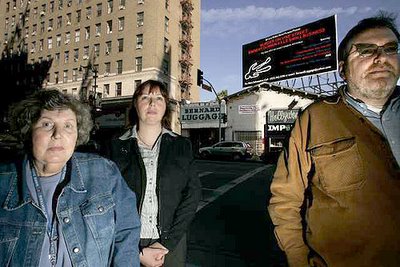 Until 2002, I lived in a sturdy brick structure that had been built in 1935 [photo above]. It was razed when the owner (who had lived there from the time the house was built until her husband died in around 1995) was sort of coerced by her daughter to sell it. The buyers knocked it down and built a cookie-cutter five-story flat.
Until 2002, I lived in a sturdy brick structure that had been built in 1935 [photo above]. It was razed when the owner (who had lived there from the time the house was built until her husband died in around 1995) was sort of coerced by her daughter to sell it. The buyers knocked it down and built a cookie-cutter five-story flat.I moved into a 25-year-old apartment I bought to use as a residence and office—an apartment that I believe was one of the original buildings to be called apat'ŭ [아파트, a Konglish truncation of apartment possibly derived from アパトー (apatō) in Japanese]. In contrast with the deep sadness I felt about hearing my 1935 house would be knocked down, I would love to see my apartment complex rebuilt into something more bigger, more modern, and with underground parking.
That is expected to happen, as this part of Yongsan is already undergoing major redevelopment. The neighborhood with the 1935 house is full of other well-built homes from before World War II that I would hate to see go. Such old buildings are still found amongst more modern buildings from more recent decades, whose owners would probably enjoy the windfall of being owners of brand-spanking-new apartments so close to downtown.
Not all owners of older homes are happy to have their places taken away. West of Gate #17 of Yongsan Garrison are several residential towers being constructed on what used to be a thicket of small houses from the 1930s, 1940s, and 1950s. The winding alleyways passing rose gardens and gingko trees was where many of these residents had lived their entire lives. But the government kicked them out—apparently without proper compensation—so the developers could build. [January 19, 2009 addendum: I think the neighborhood I described is across the street from the neighborhood where the six fiery deaths occurred in a standoff between squatters and SWAT.]
What got me thinking about all this was an article in the Los Angeles Times about the City of Los Angeles using "eminent domain" to kick long-established businesses from "Old Hollywood" to make room for a newer and hopefully more vibrant Hollywood:
With a loud thud, new Hollywood collided Thursday with old Hollywood at Tinseltown's most famous intersection: Hollywood and Vine.I understand the City's reasoning behind the $400 million development, but there's so little left of Old Hollywood, and it would be nice to preserve it.
Los Angeles officials cleared the way for a luxury hotel developer to seize buildings housing about 30 small businesses through eminent domain so a $400-million project with a W Hotel, condominium and apartment units, and glitzy shops and restaurants can be built on the southeast corner.
The condemnation proceedings, authorized by the Los Angeles Community Redevelopment Agency, set the stage for one of the most ambitious revitalization efforts in Hollywood.
But the action was loudly protested as heavy-handed and unfriendly by homeowners and merchants who said it was wrong to use public money and power to benefit a private developer.
 [photo: These people are set to lose their businesses when the corner behind them is redeveloped.]
[photo: These people are set to lose their businesses when the corner behind them is redeveloped.]Besides that is the issue of abuse of eminent domain: it's one thing to use it to build needed infrastructure, but when "the little guy" is losing his or her business so that a bigger business (this one an Orange County-based developer from Irvine) can build something, something doesn't seem right. I would hate that Daewoo, Isu, or some other construction company could force me out of my apartment just because they had the funds.
It is ironic that eminent domain enjoys a broad definition in a country whose Constitution places great value of individual freedom and property rights.
ReplyDelete